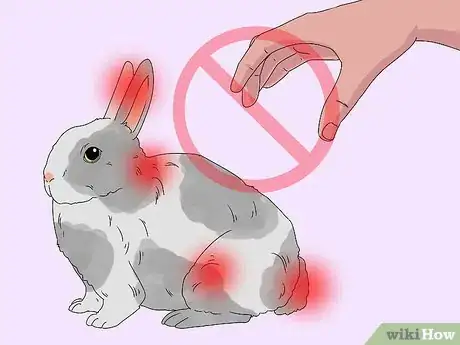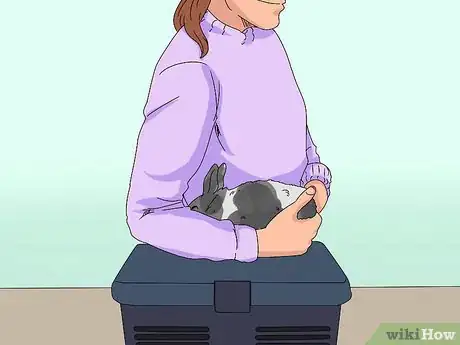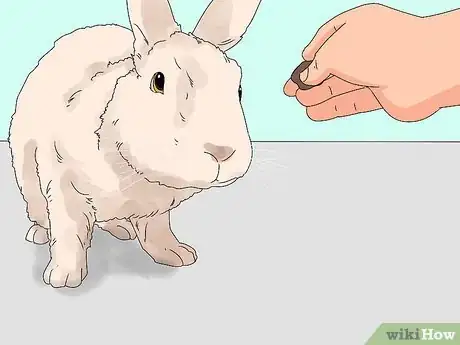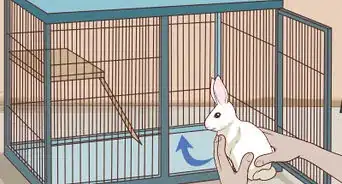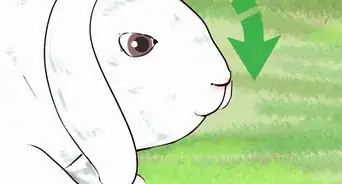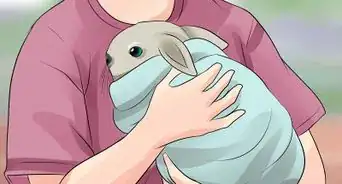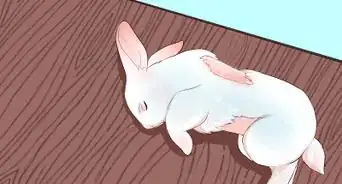This article was co-authored by Pippa Elliott, MRCVS. Dr. Elliott, BVMS, MRCVS is a veterinarian with over 30 years of experience in veterinary surgery and companion animal practice. She graduated from the University of Glasgow in 1987 with a degree in veterinary medicine and surgery. She has worked at the same animal clinic in her hometown for over 20 years.
wikiHow marks an article as reader-approved once it receives enough positive feedback. In this case, 85% of readers who voted found the article helpful, earning it our reader-approved status.
This article has been viewed 266,328 times.
Domestic rabbits make great pets because they adapt well to an indoor environment and litter box train easily. However, when you live with a house rabbit, it's important to learn how to safely pick up and restrain your pet. Rabbits have very muscular and powerful hind legs, so when they kick out with them, there is great risk that their spine or back will be injured.[1] It is not difficult to pick up a rabbit safely and properly, you just need to learn how.
Steps
Lifting a Rabbit
-
1Help your rabbit get comfortable with handling by petting the rabbit gently. Start with short intervals and increase the time with the bunny. Consider placing a nice plate of greens out for the rabbit to eat while you stroke the rabbit to decrease any potential anxiety.
- Don't make sudden moves or sounds that might alarm your rabbit. Be gentle and soothing when you pet the rabbit. Rabbits are prey animals, so when they feel threatened, they run and hide if they can.
- Sit on the floor to minimize your size and avoid towering over the bunny.
-
2Know how not to pick up a rabbit. Never pick up a rabbit by his ears, legs, scruff, or tail.[2] Rabbits are very delicate and you could severely injure them if you pick them up incorrectly.[3] Grabbing on to limbs, tails, or ears will cause the rabbit to react by pulling away. Doing so may cause a fracture or a dislocation or tearing of underlying muscle and soft tissue.[4]
- A bunny new to the household should be picked up and restrained by adults at first. Children can pet the bunny while it is on the floor or while sitting in the child’s (or adult’s) lap sitting on the floor.
- Staying close to the ground for a while is a good preventative measure. Should the rabbit try to escape, they will not fall a long distance and potentially injure themselves.
Advertisement -
3Practice placing your palm under the rabbit's chest and gently lifting its front legs off the ground, then setting it back down. Reward the rabbit with a treat afterward. This will help it get used to the feeling of being picked up.[5]
-
4Gently use the loose skin behind the rabbit’s neck to hold onto its scruff. Do not pick the rabbit up by the scruff alone, but use this as a handle to prevent forward motion while you use your other hand arm to tuck the hind legs under the bunny and scrunch the bunny in a gentle “bunny ball.”
- Your free hand that is not holding the scruff should be placed on the bunny’s rump. You should roll the back legs underneath, toward the front of the bunny, holding the feet up with your hand. This will prevent the rabbit from kicking out and potentially injuring itself.
- There are differing opinions on whether or not to scruff a rabbit. Scruffing, done gently, does not injure the rabbit.[6] [7]
-
5Use two hands to lift the rabbit up. Place one under his chest and one under its behind. The positioning should be comfortable for both you and the rabbit. Make sure you have a firm (but not tight) grip on the rabbit's body so that it doesn't leap from your hands when you lift.
- Make sure to contain the hind legs securely, by keeping your hand on the rump and scrunching the hind legs up toward the bunny’s head. Remember, you are holding the hind legs so that they point forward, toward the head, the opposite direction of where the hind legs would be should the bunny kick out.
- It may help to kneel to get closer to the rabbit, so you don't have to bend and lift. Get down on the ground with the rabbit.
-
6Use the right approach. It's best to lift a rabbit either from a top-opening cage or a confined area in your house. It can be much more difficult to lift a rabbit from a side opening cage. Rabbits will often run and hide when approached, so trying to pick up a rabbit in a room with lots of furniture will also be difficult.
- When removing a rabbit from a side or front opening carrier, do so with the hind legs first out of the opening. That way, if they get out of your grip, they will jump back into the carrier and not down to the ground.[8]
- Use one hand to hold the bunny’s head away from you, toward the back of the cage, while gently holding on to the scruff. The other hand is used over the bunny’s rump to scrunch the hind legs up into the “bunny ball” hold. Then lift the bunny out, hind legs toward you, and place under your arm so the bunny’s head is given a place to hide.
- If you are getting the bunny out of a top-opening carrier, you can use the same technique, just remember not to dangle the bunny by the scruff.
- If this is a well handled and calm bunny, you are likely to be able to safely pick up the bunny with one hand under its chest and one hand scrunching the rump, without holding on to the scruff.
- Be aware, that if the bunny feels like it might fall, it will struggle and kick and try to get down. If this happens, place the bunny back in the carrier and re-grip or go back to using the scruff to help with restraint.
-
7Coax the rabbit out of a hiding place, don't drag it out. If your rabbit tends to run under furniture, coax it out with a treat before trying to pick it up. Better yet, manage the area to prevent the rabbit from being able to get away and hide so that it doesn't have access to hiding places that are difficult for you to access. Try using an exercise pen to confine the bunny, but still allowing them an area large enough to hop around.
- Never pull on a rabbit's legs or tail to get it to move closer to you. It is better to gently get a hold of the scruff to prevent the rabbit from getting away, then you can get an arm around the rabbit’s body and contain the hind legs. Never forcefully scruff a rabbit or dangle it by the scruff. This will cause the rabbit injury.
-
8Look for warning signs that the rabbit will not allow you to pick it up. If a rabbit thumps a hind leg when you approach, be aware that this is a warning to you that you are in their territory and they are not thrilled with your presence. The rabbit may be more difficult to handle, so be prepared.
- Again, remember to use confinement within an exercise pen or other area to help you manage the rabbit’s access to hiding places and allow you find and restrain the rabbit more easily.
Holding and Carrying a Rabbit
-
1Hold the bunny with the head slightly higher than the hindquarters. Do not point its head down because the rabbit may then try to jump down, out of your arms, and may hurt itself.
-
2Lift the rabbit carefully to your side (or in front of your mid abdomen), under your arm. The rabbit will feel more secure being able to hide a bit. Your rabbit should be held and carried securely under your arm, nestled comfortably under your “wing.”[9] Some people call this the “football hold.”
- If you are right handed, place the bunny’s head under your left arm. Wrap your left arm around the outside of the rabbit while using your left hand to continue to securely hold the rabbit’s hind legs under it.
- Place your right hand gently over the bunny’s neck, ready to get a hold of the scruff should the bunny move suddenly.
- Do not hold your rabbit extended outward or swing it through the air.
-
3Pass your rabbit to another person correctly. Ideally, place the rabbit on a table and restrain it while the other person gets a hold of the bunny. Don't try to pass the bunny in mid air. This could lead to the rabbit getting loose and falling from a great height.
-
4Limit possible injury. If you ever feel like you are losing control when carrying the rabbit, immediately crouch down to the ground or to a table to decrease the distance that it might fall. This will also give you a surface upon which to regroup and re-grip the bunny.
-
5Use a carrying case or a wrap for extra-wriggly rabbits. Some rabbits really dislike being handled and no amount of treats or petting will change their personalities. For these types, it's best to use a carrying case to move them from one place to the next, rather than attempting to pick them up.
- Use one hand to hold the scruff to restrain the rabbit and get your other hand on the rump and “scrunch” the bunny in a “bunny ball” to transfer to the carrier.
Setting a Rabbit Down
-
1Lower the rabbit carefully to the ground (or a top-loading carrier) while holding the bunny in the “football hold.” There is a risk of releasing the rabbit when it is in your arms and the rabbit landing on the ground poorly and injuring itself. Be sure to keep a firm grip the entire time, because rabbits tend to try to jump once they can see the floor.
-
2Place a rabbit in a front loading carrier by putting it in hind legs first with the rabbit facing you. This method decreases the chance of the bunny kicking out and injuring itself.[10]
-
3Reward the rabbit with a treat. After spending time in your arms without biting or leaping away, your obedient rabbit deserves a treat. Gently pet it as you give it a reward. The rabbit will realize that being picked up isn't so bad, and next time it may even go more smoothly.
Expert Q&A
Did you know you can get expert answers for this article?
Unlock expert answers by supporting wikiHow
-
QuestionMy rabbit struggles hard to escape when I pick her up. What should I do?
 Pippa Elliott, MRCVSDr. Elliott, BVMS, MRCVS is a veterinarian with over 30 years of experience in veterinary surgery and companion animal practice. She graduated from the University of Glasgow in 1987 with a degree in veterinary medicine and surgery. She has worked at the same animal clinic in her hometown for over 20 years.
Pippa Elliott, MRCVSDr. Elliott, BVMS, MRCVS is a veterinarian with over 30 years of experience in veterinary surgery and companion animal practice. She graduated from the University of Glasgow in 1987 with a degree in veterinary medicine and surgery. She has worked at the same animal clinic in her hometown for over 20 years.
Veterinarian Be especially careful that you have a firm (but gentle) grip on the rabbit. Covering her with a towel and scooping her up will help her feel safer and reduce the risk of her jumping out of your arms. You may need to go back to basics by sitting on the ground and encouraging her to jump up onto your lap for a tasty treat, so that she's more comfortable with human contact, before being whisked up into the air.
Be especially careful that you have a firm (but gentle) grip on the rabbit. Covering her with a towel and scooping her up will help her feel safer and reduce the risk of her jumping out of your arms. You may need to go back to basics by sitting on the ground and encouraging her to jump up onto your lap for a tasty treat, so that she's more comfortable with human contact, before being whisked up into the air. -
QuestionIs it normal for my bunny to be 'shivering' a lot? We just got her and she seems okay when I pick her up.
 Pippa Elliott, MRCVSDr. Elliott, BVMS, MRCVS is a veterinarian with over 30 years of experience in veterinary surgery and companion animal practice. She graduated from the University of Glasgow in 1987 with a degree in veterinary medicine and surgery. She has worked at the same animal clinic in her hometown for over 20 years.
Pippa Elliott, MRCVSDr. Elliott, BVMS, MRCVS is a veterinarian with over 30 years of experience in veterinary surgery and companion animal practice. She graduated from the University of Glasgow in 1987 with a degree in veterinary medicine and surgery. She has worked at the same animal clinic in her hometown for over 20 years.
Veterinarian
-
QuestionCan I pick a rabbit up under its front legs?
 Pippa Elliott, MRCVSDr. Elliott, BVMS, MRCVS is a veterinarian with over 30 years of experience in veterinary surgery and companion animal practice. She graduated from the University of Glasgow in 1987 with a degree in veterinary medicine and surgery. She has worked at the same animal clinic in her hometown for over 20 years.
Pippa Elliott, MRCVSDr. Elliott, BVMS, MRCVS is a veterinarian with over 30 years of experience in veterinary surgery and companion animal practice. She graduated from the University of Glasgow in 1987 with a degree in veterinary medicine and surgery. She has worked at the same animal clinic in her hometown for over 20 years.
Veterinarian It's best to support the entire length of the rabbit, and your aim is to hold the rabbit with their backbone parallel to the ground. It is not advisable to pick up a rabbit by either the front or back legs alone, since the weight of the rabbit will pull on the shoulders or hips and could cause fractures or dislocations. However, scooping one hand between the front legs and one hand under the bottom is perfectly fine.
It's best to support the entire length of the rabbit, and your aim is to hold the rabbit with their backbone parallel to the ground. It is not advisable to pick up a rabbit by either the front or back legs alone, since the weight of the rabbit will pull on the shoulders or hips and could cause fractures or dislocations. However, scooping one hand between the front legs and one hand under the bottom is perfectly fine.
Warnings
- If you are outside or in a public place, be very careful to not let it get away. If it does DO NOT try to tackle it as you may injure the rabbit.⧼thumbs_response⧽
- Do not drop the rabbit. Rabbits can be seriously injured if dropped.⧼thumbs_response⧽
- Always contain the hind legs so that the rabbit cannot jump out of your arms. This will also prevent the rabbit from scratching you with its back legs as well.⧼thumbs_response⧽
- NEVER try to pick up a wild rabbit, they are more likely to scratch or bite you.⧼thumbs_response⧽
References
- ↑ http://www.raising-rabbits.com/symptoms-of-spinal-injury.html
- ↑ http://www.rabbitrehome.org.uk/care/handling.asp
- ↑ http://rabbit.org/an-uplifting-experience/
- ↑ http://www.rabbitrehome.org.uk/care/handling.asp
- ↑ http://www.rabbitrehome.org.uk/care/handling.asp
- ↑ http://www.ahwla.org.uk/site/tutorials/BVA/BVA08-Rabbit/Rabbit.html
- ↑ Susan A. Brown, “Clinical techniques in rabbits,” Seminars in Avian and Exotic Pet Medicine, Volume 6, Issue 2, April 1997, Pages 86-95.
- ↑ http://rabbit.org/an-uplifting-experience/
- ↑ Susan A. Brown, “Clinical techniques in rabbits,” Seminars in Avian and Exotic Pet Medicine, Volume 6, Issue 2, April 1997, Pages 86-95.
About This Article
To pick up a rabbit, place one hand under its chest, and the other under its rump while pushing its hind legs forward. If the rabbit is in a side-opening cage, use one hand to hold the rabbit’s face away from you while gently holding onto the skin behind its neck. Place your other hand under the rabbits rump and push its hind legs forward. This will make a “bunny ball” where one hand forms a seat while your grip on its skin keeps it from falling off while you take it out. For advice from our Veterinary reviewer on safely handling the rabbit, read more!

